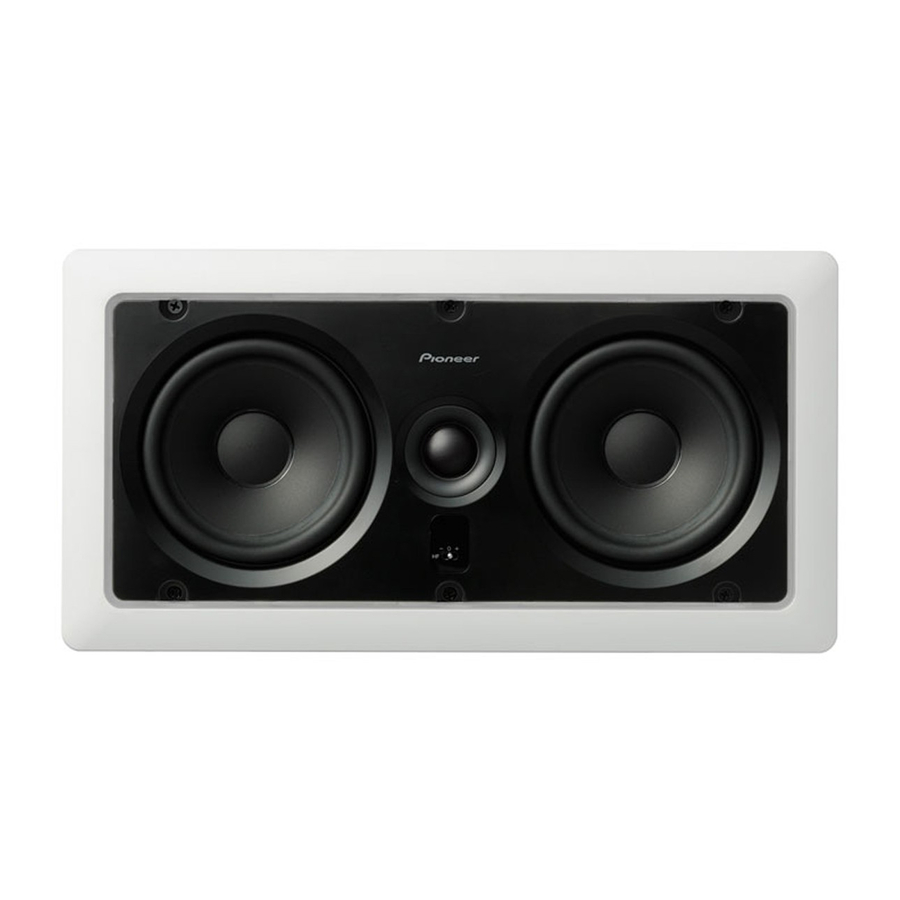Pioneer S-IW531L - In-Wall Left Center Right Pivoting Soft Dome Tweeter Speaker Operating Instructions Manual - Page 5
Browse online or download pdf Operating Instructions Manual for Speaker System Pioneer S-IW531L - In-Wall Left Center Right Pivoting Soft Dome Tweeter Speaker. Pioneer S-IW531L - In-Wall Left Center Right Pivoting Soft Dome Tweeter Speaker 17 pages. In-wall speaker
Also for Pioneer S-IW531L - In-Wall Left Center Right Pivoting Soft Dome Tweeter Speaker: Brochure & Specs (8 pages), Specifications (1 pages)

• If the wires are pulled out of the terminal posts and
the conductors come into contact with each other or
surrounding devices, an excessive additional load
may be placed on the amplifier. This may cause the
amplifier to stop functioning, and may even cause it
damage.
• Be careful to observe the correct polarity of the
connections between the cables and the speaker. If
the polarity (+, –) of one of the speakers (left or right)
is reversed the stereo image will be severely
degraded.
CAUTION
These speaker terminals carry HAZARDOUS LIVE
voltage. To prevent the risk of electric shock when
connecting or disconnecting the speaker cables,
disconnect the power cord before touching any
uninsulated parts.
7
Where available, use the fixing bracket located on
the back of the speaker system and attach a reinforced
wire, such as stainless steel wire rope, to the studs or
beams of the walls/ceiling.
• It is strongly recommended that you take double safe
precautions to prevent the speaker from falling by
accident.
Fixing bracket
Reinforced wire
(not supplied)
• Put the reinforced wire through the fixing bracket and
attach to the studs or beams. Make sure the stud/
beam that you are attaching it to is strong enough to
support the weight of the speaker system.
8
Place sound-absorbing material (such as fiberglass)
around the speakers as necessary to improve sound
quality.
Use only sound-absorbing materials that comply with
regional safety regulations.
9
Place the speaker into the hole you have cut.
Make sure the rotating clamps are turned inward.
• A Phillips screwdriver is required for loosening them.
• When using electric screwdrivers, first find out the
minimum torque required for the installation of the
speaker system. Begin by setting the electric
screwdriver to its minimum torque and gradually
D3-4-2-2-3_A_En
Stud/beam
raise the torque until the screw starts to rotate. Check
what torque setting you are on at this point (this will
be the minimum torque required for the setup). After
confirming the torque, return the rotating clamps
toward the inside by reversing the direction of
rotation of the screws. When doing this, take care
that the screws do not come all the way out.
Rotating clamp
Speaker frame
10 Attach the speaker frame to the wall/ceiling, and
tighten the screws lightly (temporary attachment).
At this point the rotating clamp will rotate so that the
rotating clamp and frame are clamped on to the wall/
ceiling.
Gently try pulling the speaker forward and check that all
of the rotating clamps have rotated outwards and are
lightly clamping to the wall/ceiling.
11 Tighten the screws firmly using no more than the
maximum torque specified.
Allowable maximum torque: 1.0 N⋅m
• Screwing them in too tightly could break the rotating
clamps, twist the frames, damage the walls/ceilings
and make it difficult to attach the grille.
12 Make sure that the screws are not crooked and that
there is no gap between the wall/ceiling and frame.
13 Adjust the angle of the tweeter.
Gently press the edge of the tweeter flange to adjust the
angle of the tweeter as desired. Be careful not to touch
the diaphragm while doing this.
Make sure not to touch the
diaphragm as it can be
easily damaged.
Screw
5
En
